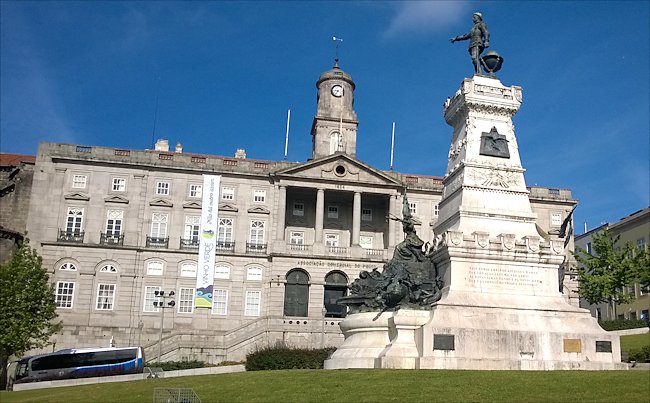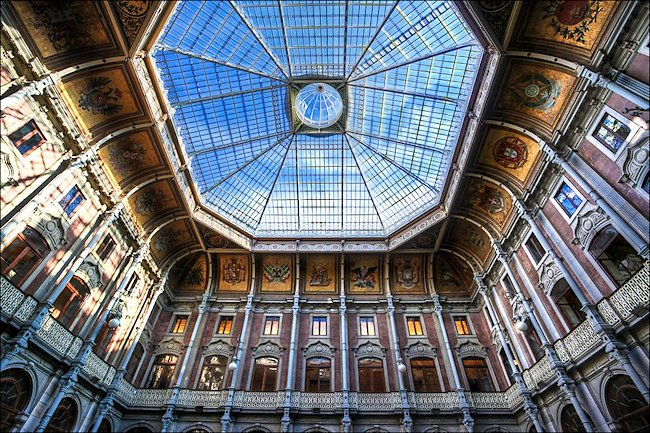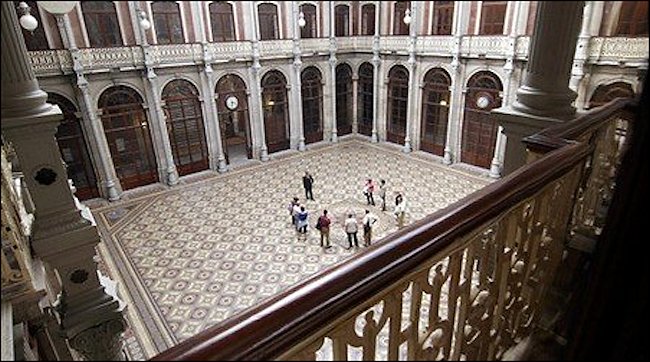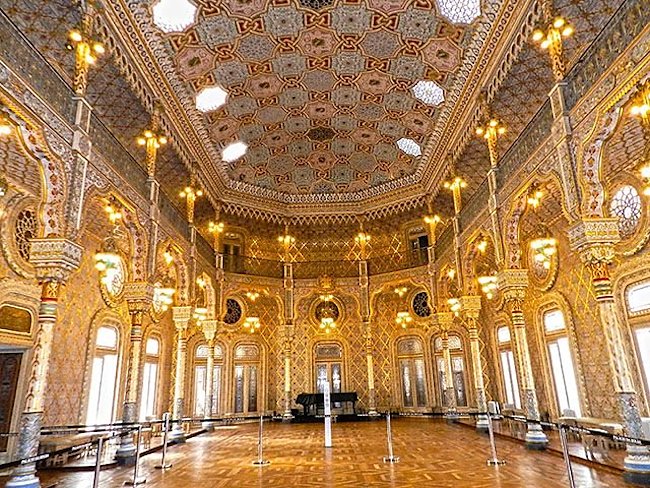The Old Stock Exchange of Porto
This is not to be missed. The inside of this building is amazing and unexpected. It opens at 9am, earlier than many other Porto attractions.

The Stock Exchange of Porto and Henry the Navigator Statue
It is a good place to visit straight after breakfast. It is housed in a building called Palacio da Boisa, the Stock Exchange palace. You will find it on the road called Rua Ferreira Borges looking onto a small green square that has a statue of Henry the navigator in the middle. It has a very formal neo-classical symmetrical frontage. Work started in 1842 and was finished in 1850. It was built by the city's Commercial Association on the site of the cloisters of the nearby St Francis Convent that had been destroyed in 1832 by fire during the Portuguese Liberal Wars. It was built in a pompous, formal style to impress foreign merchants and dignitaries.
Go up the main steps and into the gift shop. This is where you buy a ticket and are told when the next guided tour in your language will start. It is worth the wait. You cannot just walk around the building. You have to take a tour. This is the building where the rich Porto merchants meet and discussed business. You can get 50% discount off your entrance ticket with the Porto Card. The tours stop for lunch at 12.30pm and restart at 2pm. The building shuts at 5pm.
The final interior decoration was not finished until 1910. Each room has a different style. Many different interior designers were commissioned to make each room different. In the photograph below you can see flags and heraldic crest frame the skylight. These represent most of the countries that had trade relations with Porto.

The skylight glass window of the Stock Exchange of Porto
The first section of the Stock Exchange you visit as part of the tour is the old trading floor called the patio das Nacoes (Courtyard of Nations). The tiled and mosaic floor was inspired by the Greco-Roman floors unearthed at Pompeii. This section of the building was completely restored in 2008.
The grand staircase called the Escadaria Nobre, is impressive. It is a divided staircase that leads to the 1st floor offices. It was built in granite and is decorated with stone garlands of flowers, Corinthian capitals and fluted pilasters. It has two large bronze electric powered chandeliers hanging from the cupola which is a reminder that the Place was the first to be electrified in the City of Porto.

The trading floor of the Stock Exchange of Porto - Patio das Nacoes
The Commercial Courtroom, Sala do Tribunal, was where disputes between merchants and merchants and their customers were heard. It is a complete contrast to other rooms in the palace as it was designed in the French Renaissance style. There are lots of large oil paintings that cover most of the room's walls. They depict the tradesmen of Porto as well as tribunals held during medieval times. The courtroom wooden chairs and tables used by guild members are very ornately carved and contrast dramatically with those used by the members of the public at the back of the room. Walk in the middle of the courtroom and look up. The painted plaster ceiling is very attractive.
If you are visiting the old Stock Exchange and Porto with teenagers take them into the Sala do Telegrapho and ask them to find the iPhone of the 1850s. Under a protective glass cover on a desk in the middle of the small room is an ancient telegraph machine that was used to pass information about merchandise being loaded and unloaded from the boats on the River Duro.

The ornate Moorish Arabian Room in the Stock Exchange of Porto
The most notable room in the Palace is the Arab Room (Salao Arabe). It is so over the top. It has a wow factor that was intended to impress. It was built between 1862 and 1880 by Goncalves e Sousa. This elaborately decorated reception room is in the exotic Moorish Revival style. Parts of Portugal were occupied by the North African Moors until the middle 1200s. Their craftsmanship and artistic influence can still be seen today. The extensive use of ceramic glazed tiles for interior and exterior building decoration in Porto is the most noticeable Moorish legacy.
The architect Gustavo Adolfo Goncalves de Sousa, was inspired by the Moorish Alhambra Palace in Southern Spain. He started construction on 15th September 1862 and 18 years later on 12th June 1880 he announced it was complete. The floor is made up of the finest woods, such as mahogany, rosewood, satin wood, rosewood and sycamore. The Arab room is used for the most important official ceremonies of the city of Porto. It is also the venue used for many hundreds of concerts.
Travel books

